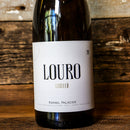Description
As quaffable and enjoyable as Godello can be from Valdeorras, it rarely reaches the level of richness, balance and complexity as it does in the hands of Rafael Palacios. Having left his family’s estate in Rioja in 2004, Rafa settled in the Val do Bibei, a rugged, weathered and off the beaten path sub-zone of Valdeorras. Bordering Ribera Sacra, the Val do Bibei is a tortured landscape of granitic, terraced slopes dotted with hard to reach and hard to farm vineyard plots. Whereas most of the rest of the DO is at lower elevation with limestone and schist soils, Rafa works exclusively with Godello planted on granitic soils at much higher elevations – so high that late Spring snow and frost are ever present dangers to his already low yields. Locally these plots are known as sorte, a word in the local dialect that refers to the practice of drawing lots to determine inheritance. Rafa has assembled 24.5 hectares of vines divided among 32 sorte. Some plots he owns outright, others are on long-term lease. The oldest vines, some nearing a century, are head pruned while the younger vines on more gentle slopes are trellised. The farming is minimalist since the sub-zone is blessed with free draining soils and warm, dry summers. All the vineyard work done by hand, including harvesting. Louro is a blend of Godello with a small amount of Treixadura from parcels located in the villages of Chandoiro, Lentellais, Outardepregos and Santa Cruz. After decades of conventional farming, the organic practices of Rafa have begun to revitalize the soils of these sites and Louro is becoming more complex with each vintage. Louro is fermented in French oak foudres and aged on its lees for four months. Up to 10% of the blend in Louro will be Treixadura, a variety that can be found coplanted in Rafa’s sortes.
Any profile of Rafael Palacios inevitably leads to his family history. While being a scion of a famous winemaking family in Spain is an excellent way to get attention, it makes Rafa’s hard work and achievements seem fated or predetermined. If one were asked to rank the indispensable white wines from the old world, there would be very few on the list originating below 45º in latitude. Yet, only after a decade in Valdeorras, it is becoming apparent that Rafa can make wines from warmer climates that have the potential to rival Hermitage Blanc, Corton-Charlemagne, the Mosel, or the Wachau.
As quaffable and enjoyable as Godello can be from Valdeorras, it rarely reaches the level of richness, balance, and complexity as it does in Rafael Palacios’s hands. Having left his family’s estate in Rioja in 2004, Rafa settled in the Val do Bibei, a rugged, weathered, and off-the-beaten-path sub-zone of Valdeorras. Bordering Ribera Sacra, the Val do Bibei is a tortured landscape of granitic, terraced slopes dotted with hard-to-reach and hard-to-farm vineyard plots. Whereas most of the rest of the DO is at a lower elevation with limestone and schist soils, Rafa works exclusively with Godello planted on granitic soils at much higher elevations – so high that late Spring snow and frost are ever-present dangers to his already low yields.
Some plots he owns outright, while others are on a long-term lease. The oldest vines, some nearing a century, are head pruned while the younger vines on more gentle slopes are trellised. The farming is minimalist since the sub-zone is blessed with free-draining soils and warm, dry summers. All the vineyard work is done by hand, including harvesting.
Each vintage, Rafa makes two cuvées from the sandy, granitic soils of the Val do Bibei: Louro and As Sortes. When conditions are right, he will also make three single-vineyard bottlings: Sorte Antiga, Sorte Souto, and Sorte O Soro.
This profile and tasting notes were edited from the European Cellars website, along with the pictures used. For more information please visit: European Cellars.
Payment & Security
Your payment information is processed securely. We do not store credit card details nor have access to your credit card information.




